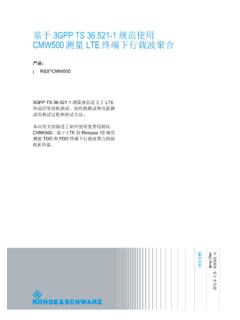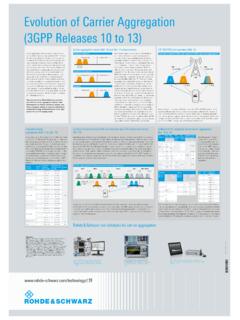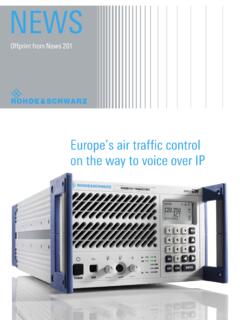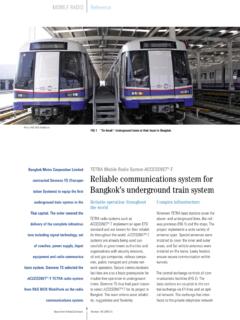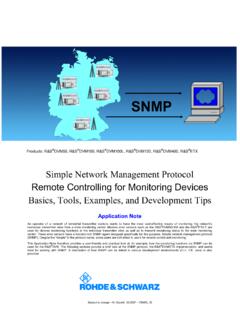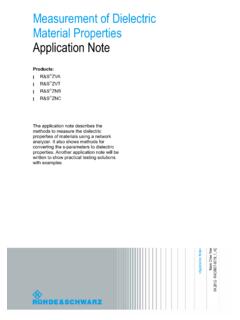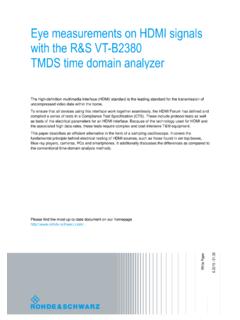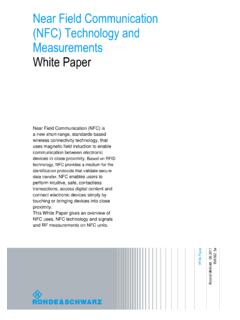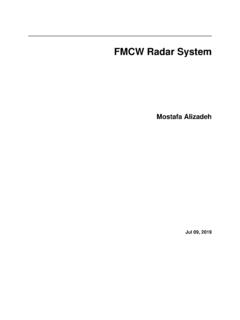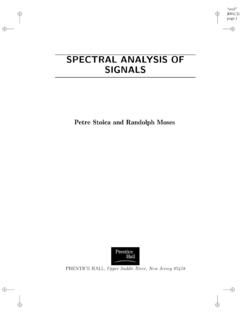Transcription of Beamforming and TM's in LTE - Rohde & Schwarz
1 LTE Transmission Modes and Beamforming White Paper Multiple input multiple output (MIMO) technology is an integral part of 3 GPP E-UTRA long term evolution (LTE). As part of MIMO, Beamforming is also used in LTE. This white paper discusses the basics of Beamforming and explains the ten downlink and two uplink MIMO transmission modes in LTE Release 12. White Paper Bernhard Schulz July 2015 1MA186_2e 1MA186_2e Rohde & Schwarz LTE Beamforming 2 Table of Contents 1 Introduction .. 3 2 MIMO and Beamforming Technologies .. 3 MIMO .. 3 Beamforming basics .. 4 Base Station Antennas .. 8 3 Transmission modes and Beamforming in LTE .. 9 Brief overview of LTE .. 9 Physical Channels and Signals .. 9 Downlink reference signal structure ..10 Transmission modes (TM) in LTE downlink ..11 TM 1 Single transmit antenna.
2 12 TM 2 Transmit diversity ..12 TM 3 Open loop spatial multiplexing with CDD ..13 TM 4 Closed loop spatial multiplexing ..13 TM 5 Multi-user MIMO ..14 TM 6 Closed loop spatial multiplexing using a single transmission layer ..15 TM 7 Beamforming (antenna port 5) ..17 TM 8 Dual layer Beamforming (antenna ports 7 and 8) ..18 TM 9 Up to 8 layer transmission (antenna ports 7 - 14) ..19 TM 10 Up to 8 layer transmission (antenna ports 7 - 14) ..21 Transmission modes (TM) in LTE uplink ..21 Test requirements in 3 GPP Release 10 ..22 Base station test ..22 UE test ..22 Summary ..23 4 Appendix .. 24 Literature ..24 Additional information ..24 Introduction MIMO 1MA186_2e Rohde & Schwarz LTE Beamforming 3 1 Introduction Modern communications networks use MIMO technology to achieve high data rates.
3 As a special MIMO technique, Beamforming also permits targeted illumination of specific areas, making it possible to improve transmission to users at the far reaches of cell coverage. Like other communications standards such as WLAN and WiMAXTM, LTE also defines Beamforming . Beamforming is particularly important for the time division duplex (TDD) mode in LTE. This white paper describes the available ten downlink and two uplink transmission modes (TM) in LTE as specified in 3 GPP Release 12, as well as how Beamforming is used in LTE. 2 MIMO and Beamforming Technologies MIMO This paper discusses the MIMO concepts only to the extent that they apply to LTE transmission modes (see ). Refer to [3] for a more detailed description of the MIMO concept as well as for a look at how MIMO is used in various communications systems.
4 MIMO systems are used to improve the robustness of data transmission or to increase data rates. Typically, a MIMO system consists of m transmit antennas and n receive antennas (Figure 1). Figure 1: MIMO system with m TX and n RX antennas MIMO and Beamforming Technologies Beamforming basics 1MA186_2e Rohde & Schwarz LTE Beamforming 4 Simply stated, the receiver receives the signal y that results when the input signal vector x is multiplied by the transmission matrix H. y = H * x Transmission matrix H contains the channel impulse responses hnm, which reference the channel between the transmit antenna m and the receive antenna n. Many MIMO algorithms are based on the analysis of transmission matrix H characteristics. The rank (of the channel matrix) defines the number of linearly independent rows or columns in H.
5 It indicates how many independent data streams (layers) can be transmitted simultaneously. Increasing the robustness of data transmission transmit diversity When the same data is transmitted redundantly over more than one transmit antenna, this is called TX diversity. This increases the signal-to-noise ratio. Space-time codes are used to generate a redundant signal. Alamouti developed the first codes for two antennas. Today, different codes are available for more than two antennas. Increasing the data rate spatial multiplexing Spatial multiplexing increases the data rate. Data is divided into separate streams, which are then transmitted simultaneously over the same air interface resources. The transmission includes special sections (also called pilots or reference signals) that are also known to the receiver.
6 The receiver can perform a channel estimation for each transmit antenna s signal. In the closed-loop method, the receiver reports the channel status to the transmitter via a special feedback channel. This enables fast reactions to changing channel circumstances, adaptation of the number of multiplexed streams. When the data rate is to be increased for a single user equipment (UE), this is called Single User MIMO (SU-MIMO). When the individual streams are assigned to various users, this is called Multi User MIMO (MU-MIMO) Beamforming basics Beamforming uses multiple antennas to control the direction of a wavefront by appropriately weighting the magnitude and phase of individual antenna signals (transmit Beamforming ). For example this makes it possible to provide better coverage to specific areas along the edges of cells.
7 Because every single antenna in the array makes a contribution to the steered signal, an array gain (also called Beamforming gain) is achieved. MIMO and Beamforming Technologies Beamforming basics 1MA186_2e Rohde & Schwarz LTE Beamforming 5 Receive Beamforming makes it possible to determine the direction that the wavefront will arrive (direction of arrival , or DoA). It is also possible to suppress selected interfering signals by applying a beam pattern null in the direction of the interfering signal. Adaptive Beamforming refers to the technique of continually applying Beamforming to a moving receiver. This requires rapid signal processing and powerful algorithms. Figure 2: Antenna array with a distance d between the individual antennas. The additional path that a wavefront must traverse between two antennas is d * sin.
8 As seen in Figure 2, the wavefront of a signal must traverse the additional distance d * sin to the next antenna. Using the speed of light c, it is possible to calculate the delay between the antennas. The signal si at each antenna is: This approximation is valid only for narrowband signals. )1(sin)1( icdiicd sin MIMO and Beamforming Technologies Beamforming basics 1MA186_2e Rohde & Schwarz LTE Beamforming 6 Written as a vector: s(t) = s(t) = a( ) s(t), where a is the array steering vector. Figure 3 shows an example of the amplitude response of an antenna array with eight elements (uniform linear array, ULA) versus the angle . In this example, the maximum is obtained when a signal coming from the boresight direction ( = 0) impinges on the array. Figure 3: Beampattern example of an 8-element ULA Beamforming is made possible by weighting the magnitude and/or phase of the signal at the individual antennas: y(t) = wH a( ) s(t), where w is the weight vector.
9 The signals are weighted so that they can be added constructively in the direction of an intended transmitter/receiver, and destructively in the direction of interferers. )1(321 Mjjjjeeee MIMO and Beamforming Technologies Beamforming basics 1MA186_2e Rohde & Schwarz LTE Beamforming 7 Because Beamforming is intended to provide the best signal possible to a UE at a specific location, finding the weight vector w is an essential step. Two basic methods for finding the weight vector can be used which also affects the arrangement of the antenna array. The distance d between the antennas is a critical factor as well. Determining the weighting using DoA If the position of the UE is known, the Beamforming weightings can be adapted accordingly to optimize transmission for this UE. Therefore, specialized algorithms, such as MUSIC [4] or ESPRIT [5]), could be used in the base station to determine the DoA for the UE signal, and thus to determine its location.
10 A uniform linear array (ULA) antenna array is typically used, where the distance d between the individual antennas is the same and d /2. This type of array can be seen as a spatial filtering and sampling in the signal space. Just as the Nyquist criterion applies to sampling a signal over time, the distance here must be d /2 in order to determine the DoA. Determining the weighting using channel estimation Other algorithms determine the optimum Beamforming weighting from a channel estimation ; for example, by using existing training sequences. In a TDD system, uplink and downlink are on the same frequency and thus the channel characteristics are the same. That is why a feedback is not needed from the UE when a suitable uplink signal is present that the base station can use to estimate the channel. In the case of TD-LTE, the uplink sounding reference signal can be used.

